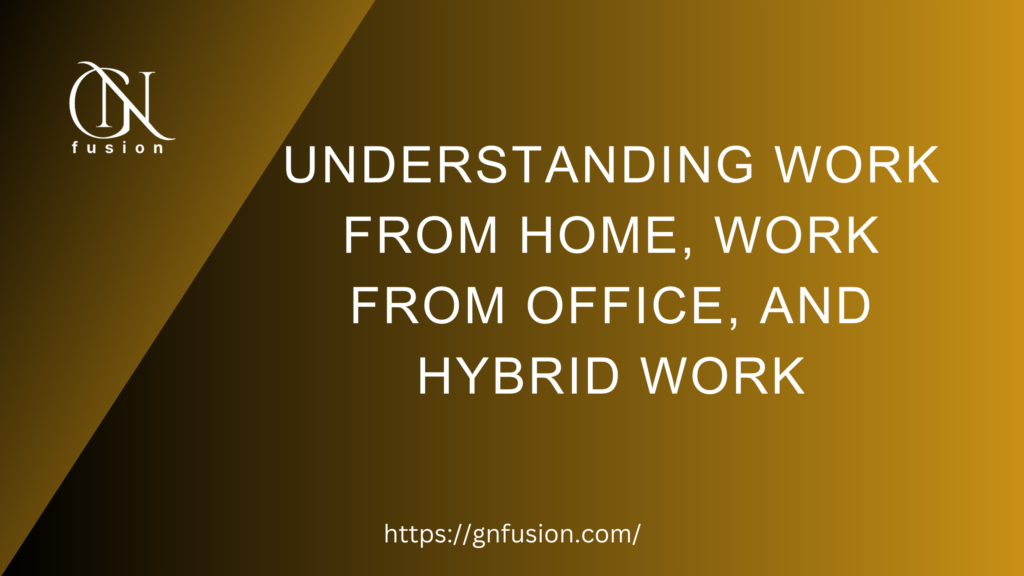Introduction:
In today’s ever-changing work landscape, flexibility and adaptability have become crucial elements for both organizations and employees. Different work modes have emerged to accommodate diverse needs and preferences. In this blog post, we will delve into the definitions and characteristics of three primary work modes: work from home, work from office, and hybrid work.
Work from Home:
Work from home, also known as remote work or telecommuting, refers to the practice of performing job duties from a location outside the traditional office environment. In this mode, employees have the flexibility to work remotely, usually from their own homes or any other suitable location. They utilize various communication and collaboration tools to stay connected with colleagues and carry out their tasks efficiently.
Advantages of Work from Home:
1- Flexibility: Working from home provides individuals with the flexibility to create their own schedules and adapt their work hours to fit personal needs and commitments.
2- Work-Life Balance: Remote work enables better work-life integration by eliminating commuting time and allowing for more time spent with family, pursuing hobbies, or engaging in personal activities.
3- Increased Productivity: Some individuals find that they are more productive when working from home due to fewer distractions and interruptions from colleagues. They can create an environment that suits their preferences and enhances focus.
4- Cost Savings: Working from home eliminates commuting expenses, such as transportation costs and dining out, resulting in potential cost savings over time.
5- Expanded Talent Pool: Remote work opens opportunities to hire talent from anywhere, regardless of geographical location, increasing access to a broader pool of skilled professionals.
Work from Office:
Work from office refers to the traditional approach of performing job responsibilities at a designated physical workplace, typically an office space provided by the employer. In this mode, employees commute to the office to carry out their work, collaborate with colleagues, and access company resources and facilities.
Advantages of Work from Office:
1- Collaboration and Teamwork: Being in an office environment promotes face-to-face collaboration, teamwork, and synergy among colleagues, enhancing brainstorming, problem-solving, and fostering innovation.
2- Access to Resources: Offices of ten provide access to specialized equipment, facilities, and resources that may be essential for certain job roles, enhancing productivity and efficiency.
3- Structured Environment: Going to the office establishes a clear separation between work and personal life, providing a structured routine and a professional setting conducive to productivity and focus.
4- Social Interaction: The office environment allows for spontaneous interactions, networking opportunities, mentorship, and team building, fostering a sense of camaraderie and connection among colleagues.
5- Organizational Culture: Being physically present in the office helps individuals align with the company’s values, mission, and culture, leading to a stronger sense of belonging and engagement.
Hybrid Work:
Hybrid work, sometimes referred to as a blended work model, combines elements of both work from home and work from office. In a hybrid work arrangement, employees have the flexibility to divide their workweek between remote work and on-site office work. The specific allocation of remote and in-office days varies depending on organizational policies, job requirements, and individual preferences.
Advantages of Hybrid Work:
1- Flexibility and Balance: Hybrid work combines the benefits of remote work and in-person collaboration, offering flexibility and the ability to balance personal and professional commitments effectively.
2- Enhanced Productivity: Hybrid work allows individuals to capitalize on the benefits of both remote and office environments, optimizing productivity based on task requirements and personal preferences.
3- Work-Life Integration: The ability to customize remote and office work days enables individuals to achieve better work-life integration, adapting their schedules to accommodate personal needs while maintaining in-person collaboration.
4- Cost Efficiency: Organizations can optimize office space utilization and reduce associated costs by implementing a hybrid work model, providing significant cost savings without compromising productivity.
5- Talent Retention and Attraction: Offering a hybrid work model can be a compelling factor for attracting and retaining top talent, as it provides a flexible work environment that aligns with the preferences of a diverse workforce.
Conclusion:
Work from home, work from office, and hybrid work are three distinct work modes that provide employees and organizations with different opportunities and advantages. Each mode offers unique characteristics, allowing individuals to find the balance that suits their job requirements, personal preferences, and work-life balance goals. As the modern workplace continues to evolve, it’s essential for organizations to embrace flexibility and tailor their work mode strategies to create a productive and fulfilling environment for their employees.
Overall, the advantages of each work mode vary based on individual preferences, job requirements, and organizational dynamics. Organizations should consider these factors when designing work mode strategies to create an environment that maximizes productivity, engagement, and work-life balance for their employees.


